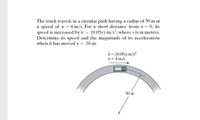
Elements Of Electromagnetics
7th Edition
ISBN: 9780190698614
Author: Sadiku, Matthew N. O.
Publisher: Oxford University Press
expand_more
expand_more
format_list_bulleted
Concept explainers
Question

Transcribed Image Text:The truck travels in a circular path having a radius of 50 m at
a speed of v = 4 m/s. For a short distance from s = 0, its
speed is increased by i = (0.05s) m/s², where s is in meters.
Determine its speed and the magnitude of its acceleration
when it has moved s = 10 m.
i = (0.055) m/s²
v = 4 m/s
50 m
Expert Solution
This question has been solved!
Explore an expertly crafted, step-by-step solution for a thorough understanding of key concepts.
This is a popular solution
Trending nowThis is a popular solution!
Step by stepSolved in 3 steps with 3 images

Knowledge Booster
Learn more about
Need a deep-dive on the concept behind this application? Look no further. Learn more about this topic, mechanical-engineering and related others by exploring similar questions and additional content below.Similar questions
- A. Determine the direction of the crate’s velocity at this instant. B. Determine the magnitude of the crate’s acceleration to this instant.arrow_forwardThe velocity of a particle moving in the x-y plane is given by (5.00i + 7.38j) m/s at time t = 3.87 s. Its average acceleration during the next 0.014 s is (2.9i+2.6j) m/s². Determine the velocity v of the particle at t = 3.884 s and the angle between the average- acceleration vector and the velocity vector at t = 3.884 s. Answers: v = ( i e = i i+ i j) m/sarrow_forward2. When a train is traveling along a straight track at 2 m/s, it begins to accelerate at a = (60v) m/s², where v is in m/s. Determine its velocity and the position 3 s after the acceleration.arrow_forward
- The truck travels along a circular road that has a radius of 50 m at a speed of 3.13 m/s. For a short distance when t = 0, its speed is then increased by at = 7t3 + 5t2 – 1 m/s2, where t is in seconds. Determine the speed and the magnitude of the truck's acceleration when t = 6.25 s. 50 marrow_forwardF12–18. A particle travels along a straight-line path y = 0.5x. If the x component of the particle's velocity is v, = (22) m/s, where t is in seconds, determine the magnitude of the particle's velocity and acceleration when t = 4 s. y = 0.5xarrow_forward2/3 The velocity of a particle which moves along the s-axis is given by v = 2 + 5t32, where t is in seconds and v is in meters per second. Evaluate the displacement s, velocity v, and acceleration a when t = 4 s. The parti- cle is at the origin s = 0 when t = 0. 214 The velocity of a particle along the s-axis is given byarrow_forward
arrow_back_ios
arrow_forward_ios
Recommended textbooks for you
 Elements Of ElectromagneticsMechanical EngineeringISBN:9780190698614Author:Sadiku, Matthew N. O.Publisher:Oxford University Press
Elements Of ElectromagneticsMechanical EngineeringISBN:9780190698614Author:Sadiku, Matthew N. O.Publisher:Oxford University Press Mechanics of Materials (10th Edition)Mechanical EngineeringISBN:9780134319650Author:Russell C. HibbelerPublisher:PEARSON
Mechanics of Materials (10th Edition)Mechanical EngineeringISBN:9780134319650Author:Russell C. HibbelerPublisher:PEARSON Thermodynamics: An Engineering ApproachMechanical EngineeringISBN:9781259822674Author:Yunus A. Cengel Dr., Michael A. BolesPublisher:McGraw-Hill Education
Thermodynamics: An Engineering ApproachMechanical EngineeringISBN:9781259822674Author:Yunus A. Cengel Dr., Michael A. BolesPublisher:McGraw-Hill Education Control Systems EngineeringMechanical EngineeringISBN:9781118170519Author:Norman S. NisePublisher:WILEY
Control Systems EngineeringMechanical EngineeringISBN:9781118170519Author:Norman S. NisePublisher:WILEY Mechanics of Materials (MindTap Course List)Mechanical EngineeringISBN:9781337093347Author:Barry J. Goodno, James M. GerePublisher:Cengage Learning
Mechanics of Materials (MindTap Course List)Mechanical EngineeringISBN:9781337093347Author:Barry J. Goodno, James M. GerePublisher:Cengage Learning Engineering Mechanics: StaticsMechanical EngineeringISBN:9781118807330Author:James L. Meriam, L. G. Kraige, J. N. BoltonPublisher:WILEY
Engineering Mechanics: StaticsMechanical EngineeringISBN:9781118807330Author:James L. Meriam, L. G. Kraige, J. N. BoltonPublisher:WILEY

Elements Of Electromagnetics
Mechanical Engineering
ISBN:9780190698614
Author:Sadiku, Matthew N. O.
Publisher:Oxford University Press

Mechanics of Materials (10th Edition)
Mechanical Engineering
ISBN:9780134319650
Author:Russell C. Hibbeler
Publisher:PEARSON

Thermodynamics: An Engineering Approach
Mechanical Engineering
ISBN:9781259822674
Author:Yunus A. Cengel Dr., Michael A. Boles
Publisher:McGraw-Hill Education

Control Systems Engineering
Mechanical Engineering
ISBN:9781118170519
Author:Norman S. Nise
Publisher:WILEY

Mechanics of Materials (MindTap Course List)
Mechanical Engineering
ISBN:9781337093347
Author:Barry J. Goodno, James M. Gere
Publisher:Cengage Learning

Engineering Mechanics: Statics
Mechanical Engineering
ISBN:9781118807330
Author:James L. Meriam, L. G. Kraige, J. N. Bolton
Publisher:WILEY